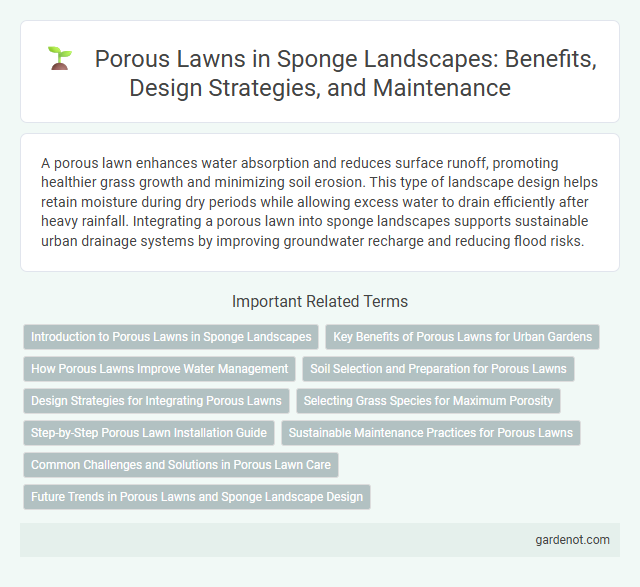A porous lawn enhances water absorption and reduces surface runoff, promoting healthier grass growth and minimizing soil erosion. This type of landscape design helps retain moisture during dry periods while allowing excess water to drain efficiently after heavy rainfall. Integrating a porous lawn into sponge landscapes supports sustainable urban drainage systems by improving groundwater recharge and reducing flood risks.
Introduction to Porous Lawns in Sponge Landscapes
Porous lawns in sponge landscapes utilize highly permeable soil and grass combinations to maximize water infiltration and reduce surface runoff. These lawns enhance groundwater recharge by allowing rainwater to pass through the soil, minimizing erosion and improving urban flood resilience. Integrating native grasses and soil amendments further increases the lawn's porosity, supporting sustainable stormwater management.
Key Benefits of Porous Lawns for Urban Gardens
Porous lawns provide excellent water infiltration, reducing surface runoff and promoting groundwater recharge in urban gardens. Their permeable soil structure improves root aeration, enhancing plant health and resilience to drought conditions. These lawns also help mitigate urban heat island effects by maintaining cooler soil temperatures and supporting diverse microbial ecosystems.
How Porous Lawns Improve Water Management
Porous lawns enhance water management by allowing rainwater to infiltrate the soil, reducing surface runoff and minimizing flooding risks. These permeable surfaces promote groundwater recharge and improve soil aeration, supporting healthier plant growth. Incorporating porous lawns in urban landscapes mitigates stormwater stress on drainage systems and enhances environmental sustainability.
Soil Selection and Preparation for Porous Lawns
Selecting well-draining, sandy loam soil enriched with organic matter optimizes water infiltration and root aeration for porous lawns. Proper soil preparation involves deep tilling and the integration of compost or biochar to enhance soil porosity and microbial activity. These practices create an ideal environment for resilient turf growth and effective stormwater management.
Design Strategies for Integrating Porous Lawns
Design strategies for integrating porous lawns emphasize the use of permeable soil mixtures and native, drought-resistant grass species to enhance water infiltration and reduce surface runoff. Incorporating layered substrates with gravel or sand beneath the turf allows efficient drainage while maintaining soil stability and aeration. Strategic placement of porous lawns in urban landscapes supports sustainable stormwater management and mitigates flood risks by facilitating natural groundwater recharge.
Selecting Grass Species for Maximum Porosity
Choosing grass species with deep root systems such as Bermuda grass, Tall fescue, or Zoysia enhances lawn porosity and water infiltration. These varieties improve soil aeration and reduce compaction through their extensive root networks, promoting better absorption and retention of rainwater. Selecting drought-resistant and low-maintenance grasses further supports a sustainable porous lawn ecosystem.
Step-by-Step Porous Lawn Installation Guide
Creating a porous lawn begins with selecting a well-draining substrate, such as sandy loam mixed with organic compost to enhance water infiltration and root aeration. Excavate the site to a depth of 15-20 cm, evenly spread the substrate, and compact lightly while maintaining enough porosity for water flow. Finish by planting drought-resistant grass varieties and installing an efficient irrigation system to ensure optimal moisture retention and prevent surface runoff.
Sustainable Maintenance Practices for Porous Lawns
Porous lawns enhance water infiltration and reduce runoff, creating a sustainable landscape that conserves water resources. Sustainable maintenance practices for porous lawns include minimizing soil compaction by avoiding heavy machinery and aerating regularly to maintain soil permeability. Employing organic fertilizers and native drought-tolerant grasses further supports soil health and reduces environmental impact.
Common Challenges and Solutions in Porous Lawn Care
Porous lawns often face challenges such as excessive water drainage, soil erosion, and nutrient leaching, which can hinder plant growth and soil stability. Effective solutions include incorporating organic matter to improve soil structure, using mulch to retain moisture, and applying slow-release fertilizers to minimize nutrient loss. Regular aeration and selecting drought-resistant grass species also enhance water retention and overall lawn resilience.
Future Trends in Porous Lawns and Sponge Landscape Design
Future trends in porous lawns and sponge landscape design emphasize sustainable water management through enhanced soil permeability and rainwater absorption technologies. Integrating bio-retention systems with native vegetation promotes groundwater recharge while mitigating urban flooding. Advanced materials and smart irrigation systems optimize moisture retention, supporting resilient, eco-friendly landscapes adaptable to climate change challenges.
Porous lawn Infographic

 gardenot.com
gardenot.com